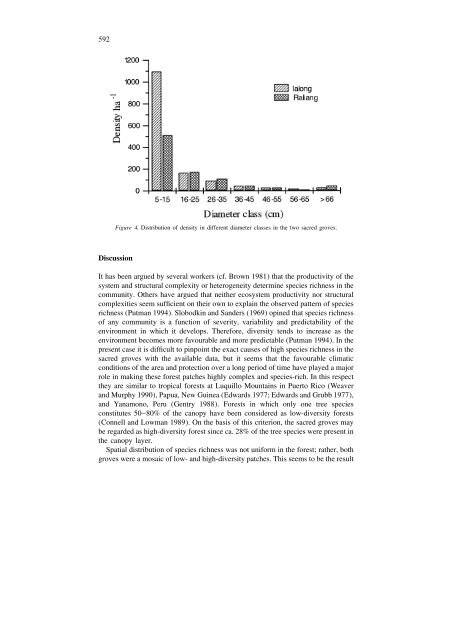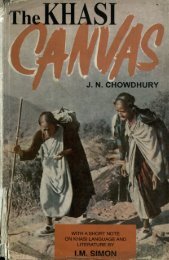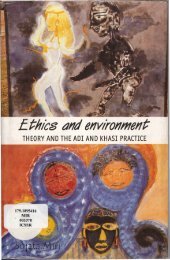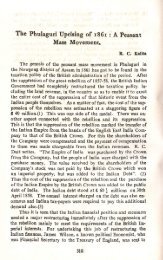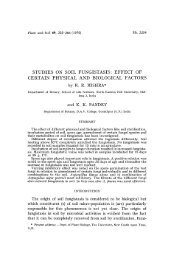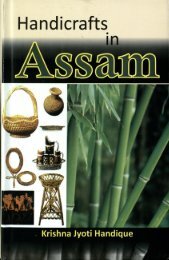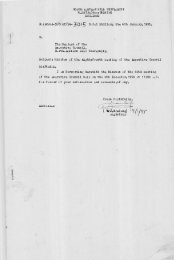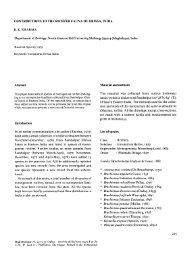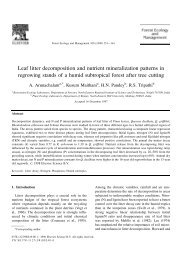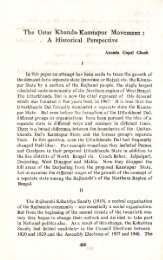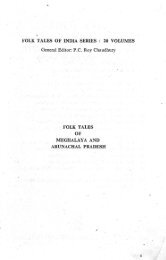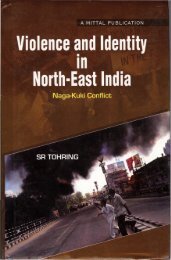Tree diversity in sacred groves of the Jaintia - DSpace@NEHU ...
Tree diversity in sacred groves of the Jaintia - DSpace@NEHU ...
Tree diversity in sacred groves of the Jaintia - DSpace@NEHU ...
Create successful ePaper yourself
Turn your PDF publications into a flip-book with our unique Google optimized e-Paper software.
592<br />
Figure 4. Distribution <strong>of</strong> density <strong>in</strong> different diameter classes <strong>in</strong> <strong>the</strong> two <strong>sacred</strong> <strong>groves</strong>.<br />
Discussion<br />
It has been argued by several workers (cf. Brown 1981) that <strong>the</strong> productivity <strong>of</strong> <strong>the</strong><br />
system and structural complexity or heterogeneity determ<strong>in</strong>e species richness <strong>in</strong> <strong>the</strong><br />
community. O<strong>the</strong>rs have argued that nei<strong>the</strong>r ecosystem productivity nor structural<br />
complexities seem sufficient on <strong>the</strong>ir own to expla<strong>in</strong> <strong>the</strong> observed pattern <strong>of</strong> species<br />
richness (Putman 1994). Slobodk<strong>in</strong> and Sanders (1969) op<strong>in</strong>ed that species richness<br />
<strong>of</strong> any community is a function <strong>of</strong> severity, variability and predictability <strong>of</strong> <strong>the</strong><br />
environment <strong>in</strong> which it develops. Therefore, <strong>diversity</strong> tends to <strong>in</strong>crease as <strong>the</strong><br />
environment becomes more favourable and more predictable (Putman 1994). In <strong>the</strong><br />
present case it is difficult to p<strong>in</strong>po<strong>in</strong>t <strong>the</strong> exact causes <strong>of</strong> high species richness <strong>in</strong> <strong>the</strong><br />
<strong>sacred</strong> <strong>groves</strong> with <strong>the</strong> available data, but it seems that <strong>the</strong> favourable climatic<br />
conditions <strong>of</strong> <strong>the</strong> area and protection over a long period <strong>of</strong> time have played a major<br />
role <strong>in</strong> mak<strong>in</strong>g <strong>the</strong>se forest patches highly complex and species-rich. In this respect<br />
<strong>the</strong>y are similar to tropical forests at Luquillo Mounta<strong>in</strong>s <strong>in</strong> Puerto Rico (Weaver<br />
and Murphy 1990), Papua, New Gu<strong>in</strong>ea (Edwards 1977; Edwards and Grubb 1977),<br />
and Yanamono, Peru (Gentry 1988). Forests <strong>in</strong> which only one tree species<br />
constitutes 50–80% <strong>of</strong> <strong>the</strong> canopy have been considered as low-<strong>diversity</strong> forests<br />
(Connell and Lowman 1989). On <strong>the</strong> basis <strong>of</strong> this criterion, <strong>the</strong> <strong>sacred</strong> <strong>groves</strong> may<br />
be regarded as high-<strong>diversity</strong> forest s<strong>in</strong>ce ca. 28% <strong>of</strong> <strong>the</strong> tree species were present <strong>in</strong><br />
<strong>the</strong> canopy layer.<br />
Spatial distribution <strong>of</strong> species richness was not uniform <strong>in</strong> <strong>the</strong> forest; ra<strong>the</strong>r, both<br />
<strong>groves</strong> were a mosaic <strong>of</strong> low- and high-<strong>diversity</strong> patches. This seems to be <strong>the</strong> result


